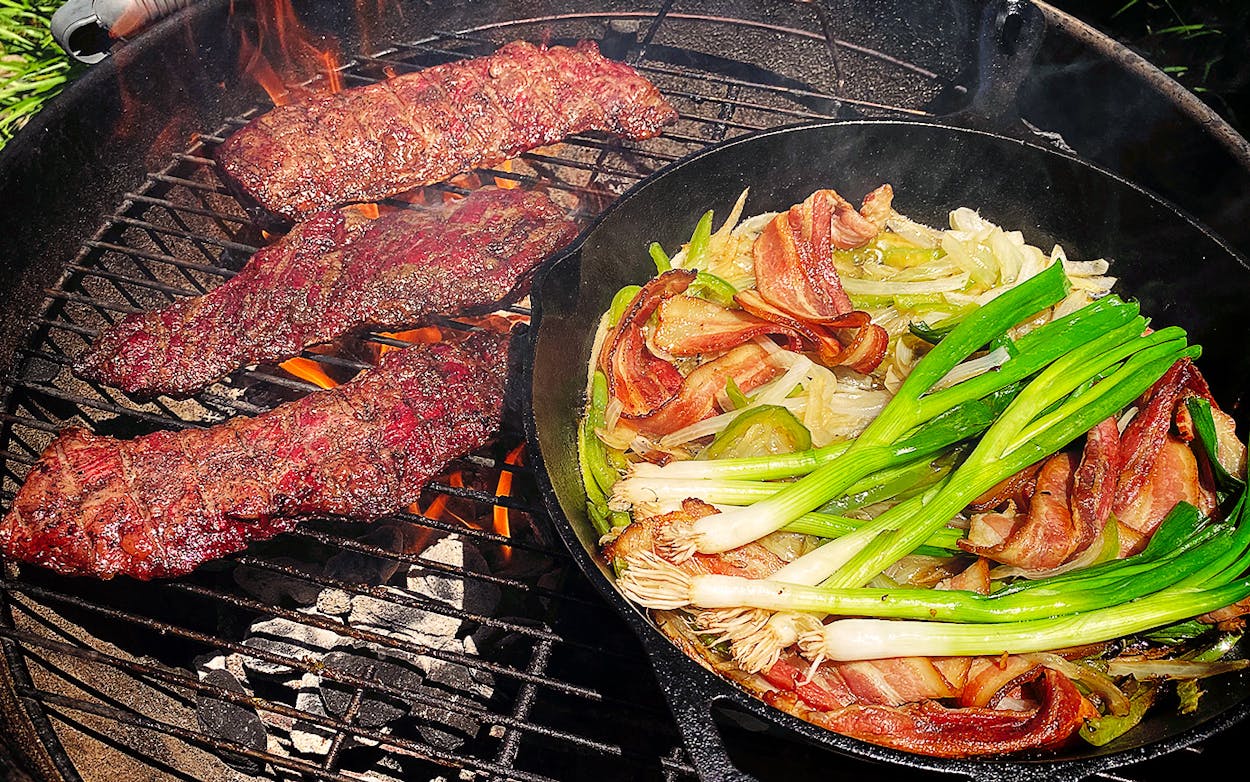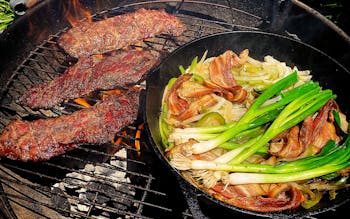When my family and I go out for Tex-Mex (which is was often), they get their fix of tacos, carne asada, or enchiladas. I, however, almost always order fajitas (other than that temporary diversion into Tex-Mex ribs). We haven’t eaten inside a restaurant for months, and fajitas don’t exactly travel well. A takeout order of fajitas isn’t the same, and it’s not just because I miss the smell of sizzling fajitas wafting through the dining room at Mariano’s Hacienda, our usual stop in the neighborhood. The thin skirt steak quickly cools after it leaves the grill (hence the hot plancha), and the juicy cut is meant to be eaten immediately after slicing. These days, I can only get that at home. But what’s the best way to cook them, and what beef cut should you choose?
Let us first discuss beef skirt steak, the classic choice for fajitas. There’s a difference between inside skirt steak and outside skirt steak. They both come from the front section of the beef plate, which is the same portion of the steer where we find beef plate ribs. The outside skirt steak is attached to the inner surface of the rib cage (it is the steer’s diaphragm), while the inside skirt comes from the belly just below the bottom of the ribs. You can identify the outside skirt because it has a membrane on both sides of the muscle that must be trimmed off. The inside skirt has membrane only on one surface. Another easy way to tell them apart at the grocery store is that you’ll almost never find outside skirt steak at the grocery store.
Outside skirt steak is more tender than the inside skirt. It usually goes to restaurants and to the export market. If you find it at your butcher’s counter, it’ll be more expensive than inside skirt. Online meat purveyor D’Artagnan carries a few varieties of outside skirt, and they sent me some of their wagyu outside skirt steak to experiment with. After it arrived, my first call was to Miguel Vidal of Valentina’s Tex-Mex BBQ in Austin.
An unsung hero of the Valentina’s menu is the smoked fajitas. I first tried them at breakfast in their version of a steak and egg taco, and I was hooked. The meat was incredibly tender, with a hint of smoke and a savory flavor throughout. Vidal uses inside skirt steak, and credits a combination of a marinade and the slow cooking in his mesquite-fired smoker for the tenderness of the meat. For each order, the smoked skirt steak is then grilled to finish it. In addition to his pointers, he gave the recipe for his marinade, which uses beer, lime juice, onions, and garlic.
At home, I had three packages of outside skirt steak to work with. I used the Valentina’s marinade on one package, a simple salt and pepper rub on another, and, for a twist, I made Roy Choi’s kalbi-style marinade recipe from his book L.A. Son (Los Angeles Magazine published a similar recipe in 2013). Choi made his name with Korean tacos at the Kogi BBQ truck in Los Angeles, and I tasted how well that marinade paired with smoked beef short ribs when he served them at the first Hot Luck festival in Austin. Reader, that marinade worked even better on smoked skirt steak.
For all three packages of skirt steak, I placed them in the marinade or applied the rub the night before cooking. I smoked them all the next day with mesquite wood for an hour at 250–270 degrees, and had a charcoal grill lit to complete the cook. On the grill, I also sautéed some green bell peppers and sliced onions in a cast-iron pan for the fajitas. While debating which oil to choose for the pan over the high heat of the grill, I remembered a half-pound of bacon I had in the fridge. I fried the bacon in the pan and used the drippings to cook the peppers and onions. Both the kalbi steak and the salt-and-pepper steak were ready for the grill, but I needed extra seasoning for the Valentina’s steak. Vidal admitted that his secret weapon was Fiesta brand Extra Fancy Fajita Seasoning, and I happened to have some in the spice cabinet.
The steaks were all a success—and incredibly tender. The wagyu steaks were naturally well marbled, and the outside skirt steak was already going to be more tender than inside skirt. Vidal suggested that with such a tender cut that one could skip the marinade and instead spritz the meat every fifteen minutes with a mix of lime juice and beer as it smoked.

A final note: For all three types of fajitas that I smoked, I served them on flour tortillas, although corn tortillas (the default at Kogi BBQ) would be great as well. If you’re in Austin, be sure to add a dozen tortillas to your takeout order from Valentina’s next time you pick up a barbecue package. I added some guacamole and quick-pickled jalapeño strips to the peppers and onions (and bacon) on the taco with the Valentina’s skirt steak. I also made some chimichurri and salsa criolla (which did double duty when I smoked tri-tips the following day) for the salt-and pepper skirt steaks. I bought a jar of kimchi for the kalbi marinated skirt steak, and added some quick-pickled onions to that taco. My chopping hand was very worn out from the previous day, so I’d choose only one of these options the next time I smoke fajitas.
- More About:
- Recipes
- BBQ Recipes









